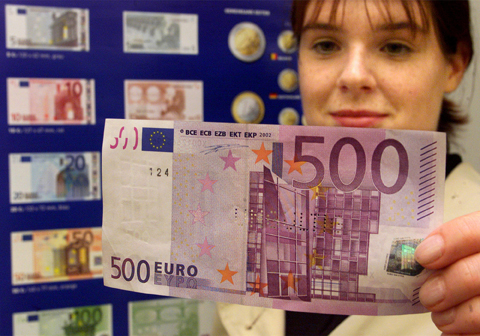 FLENSBURG, Germany: In this Sept 1, 2001 file photo, a woman holds a €500 banknote during a public presentation of the new currency at the branch office of the German Federal Bank. - AP
FLENSBURG, Germany: In this Sept 1, 2001 file photo, a woman holds a €500 banknote during a public presentation of the new currency at the branch office of the German Federal Bank. - APFRANKFURT: The European Central Bank yesterday said it would stop producing and issuing 500-euro banknotes, amid fears that the violet-colored bills were favored by criminals for money laundering and even terrorist financing. The bank is to stop issuing the €500 bills ($580) around the end of 2018 although those currently in circulation will remain legal tender. Existing bills can also be exchanged at national central banks of eurozone nations for an unlimited period of time, added the ECB, announcing its decision to scrap the denomination after "taking into account concerns that this banknote could facilitate illicit activities".
The largest denomination banknote in the single currency area is one of the world's most valuable bills, alongside the 1,000 Swiss franc ($1,045, €910) note. It is physically also the biggest than the five other euro banknotes and believed to be favored by criminals for moving large sums of money around without the authorities' knowledge. "Such notes are the preferred payment mechanism of those pursuing illicit activities, given the anonymity and lack of transaction record they offer, and the relative ease with which they can be transported and moved," according to a recent Harvard University study.
Because of its size and portability, the €500 note has become so prized in underground finance that it can trade at more than its face value, and has become known in some circles as a "Bin Laden", the study said. A million euros worth of €500 notes weigh just 2.2 kg and pack easily into a laptop bag, while the same sum transported in €50 denomination comes up to 22 kg and requires the usage of a large sports bag.
The €500 note is "used more for hiding things than buying them," said French Finance Minister Michel Sapin in March. "It is used more to facilitate transactions which are not honest than to allow you and me to buy food to eat," he said. France is pushing to step up the fight against terrorist financing in the aftermath of the bloody series of attacks in Paris in 2015. But resistance to the abolition of the €500 banknote runs high in neighboring Germany, where most people still prefer to make payments in cash even for big ticket items like electronic goods.
When the euro was created, it was Germany that had been keen to have a €500 bill because it was of a similar size denomination as its 1,000-deutschemark banknote. In Europe's top economy, where credit cards were only accepted in major electronic chains late last year, opponents of the note's abolition are concerned that it would simply be the first step in scrapping cash altogether, replacing it with electronic payment systems that can be completely monitored by authorities.
Some experts have also suggested that dropping the €500 note would contribute little to fighting crime. "Organized crime isn't stupid. Most money is laundered without cash via bogus companies," said Friedrich Schneider, an expert on the shadow economy at the University of Linz in Austria in interviews to a number of German media recently. According to ECB statistics, the €500 bills account for just three percent of the total number of banknotes in circulation, but 28 percent of the total value. - AFP










